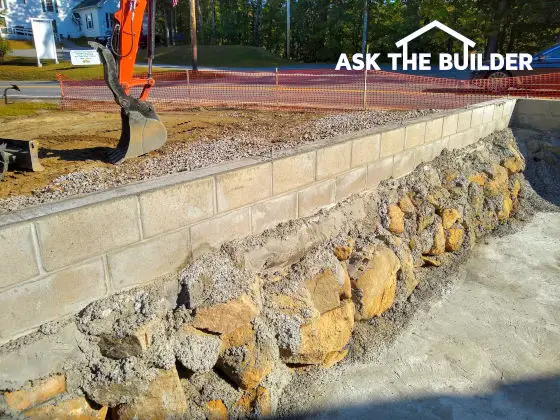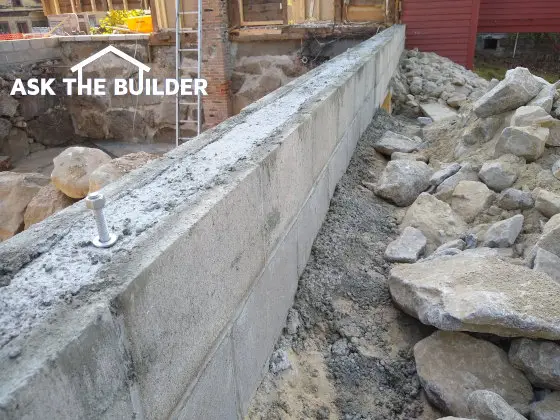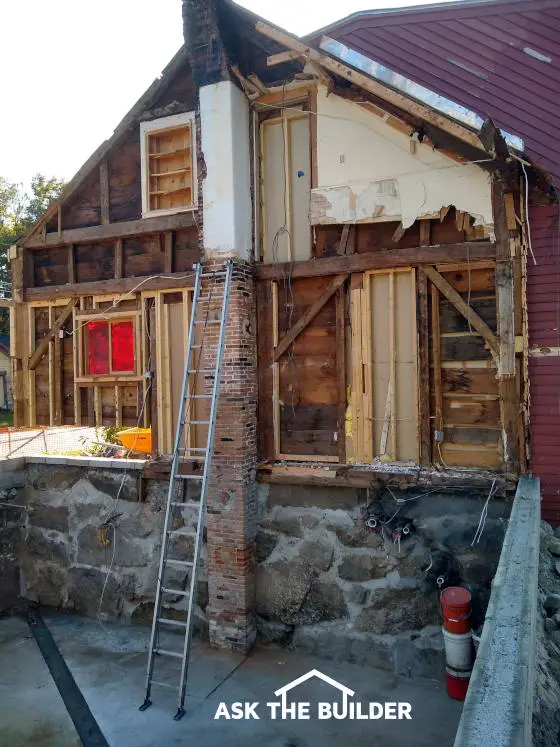
This stone foundation very likely was built in the 1840s in central New Hampshire. It will support a new apartment building with the help of the concrete block for at least another 200 years! (C) Copyright 2019 Tim Carter
DEAR TIM: I’m thinking of buying a dilapidated old frame house out in the country. It’s got a stone foundation that seems to me to be too close to the ground. Are stone foundations adequate and strong? Is it possible to add more stone or concrete to get the foundation higher? How would you recommend connecting the new concrete to the old stone? If you have a solution, I’m going to make an offer tomorrow! Shannon P., Cavendish, VT
I was born and raised in the Midwest, Cincinnati, Ohio to be exact. I was blessed to be surrounded by tens of thousands of homes built with stone foundations. The greater Cincinnati area is blessed to rest upon the world type section of the upper Ordovician Period rock strata. This means it’s got countless tons of thick limestone rocks that can be used to make magnificent foundations and retaining walls.
I owned a house built in the late 1800s in Cincinnati that had a stone foundation. The stone foundation was in perfect condition when I purchased the house in 1976. It still is today as I know the current owners. Most stone or rock is naturally durable and if you install it correctly in a foundation it can be as strong or stronger than a new cast concrete foundation! I know that’s hard to believe, but it’s true.
I’ve got great news for Shannon or you if you’re thinking of purchasing a house with a stone foundation that’s in good shape and not tumbling into the basement or crawlspace. You can add more stone, concrete block, or poured concrete to the top of it to give you a perfectly flat and square new foundation.
There are any number of ways to repair a stone foundation or add to it, but I prefer to use concrete block for the task. Concrete block typically have two hollow cores that can really come in handy when you need to connect the new block to the old stone.

The concrete block can be chiseled and cut with ease if a stone or two is a little too high. There are gas-powered saws you can use or you can do it the old fashioned way with a hammer and cold chisel.
Once the first course of concrete block is laid upon the stone, you can use a hammer drill to create 1/2-inch holes into the stones. Place a 16-inch-long drill bit into the drill and put the bit into the center of one of the hollow cores of the concrete block and drill down into the stone about 4 or 5 inches.
If you’re just adding one row of concrete block to the stone foundation, cut pieces of 1/2-inch steel rebar about 11 inches long. Use a four-pound hammer to tap the rods into the drilled hole. They typically go in with moderate effort. You want the top of the rod just below the top of the concrete block.
I’d space the rods every 24 inches on center if possible. This puts a steel rod in every other concrete block. Once all the rods are in place, you then mix up concrete to fill the cores of the concrete block. I prefer to use pea gravel as the aggregate when filling the concrete block. The smaller stones in the mix work very well if, by chance, your concrete block are multiple courses high.
In the event that you’re adding multiple courses of concrete block on top of the stone, I’d give serious consideration to using a special bond-beam concrete block as the top course. These blocks are very unusual because they have a hollow center that looks like the letter U when you look down the end of the block.
If you can visualize a long row of these placed end-to-end, I believe you can see how you can fill that long U-shaped void with concrete along with long 3/8-inch steel rods. Doing this is the closest thing you can get to a poured concrete foundation that has steel rods near the top to help hold the foundation together.
An expert mason will be very familiar with these bond beam block and will most likely recommend them too. They’re not too difficult to install for a pro. The concrete and steel rods really will make for a superior foundation for the structure you intend to place on top of the lower stone foundation.

One of the advantages of using concrete block on the stone foundation is you can do the job faster than trying to monkey around with traditional forms used for cast or poured concrete. Cast concrete foundation forms prefer to rest on top of a new level footing. Stone foundations are rarely that smooth.
Another key point is you generally only need to add 8 or 16 inches to the top of the stone foundation to get it to the preferred height above grade. A great block mason can have this done before the poured concrete contractor can set his forms and bring in the ready-mix trucks.
Column 1324
The post Stone Foundation Repair Rebuild appeared first on Ask the Builder.
Via builders feed http://www.rssmix.com/
No comments:
Post a Comment